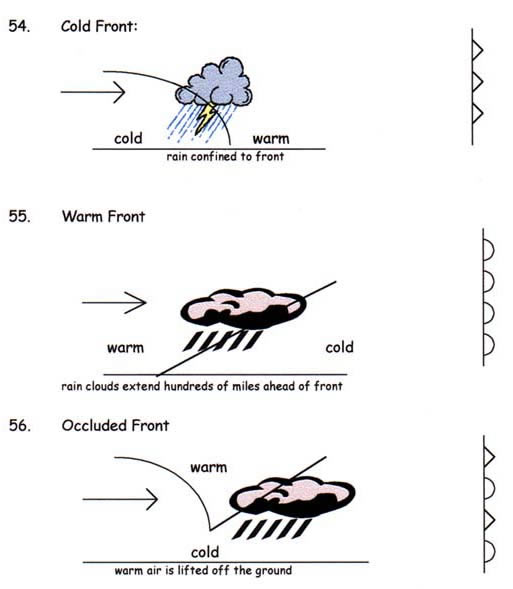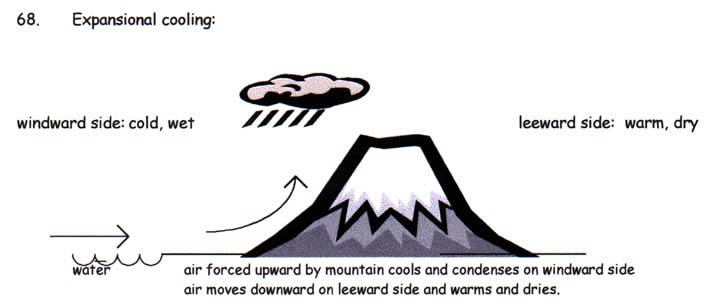Mr. Nap's Excellent Earth Science Page
117 Ways to Pass the
Earth Science Regent's
1.
The same substance always has the same density
2. As pressure increases, density increases
3. As temperature increases, density decreases
4. Water expands when it freezes
5. Most changes are cyclic
6. Water is most dense at 4oC, when it is a liquid
7. The universe began with a big explosion--"The Big Bang." Proof = cosmic background radiation from the explosion
8. The best model of the Earth is a sphere
9. The altitude of Polaris equals your latitude
10. Our solar system is located on one of the outer arms of our Milky Way Galaxy
11. Latitude lines go east-west, just like the equator, but measure distances
north or south.
12. Longitude lines go north-south, but measure distances east or west.
13. Longitude is based on observations of the sun
14. Use the reference tables
15. The closer the isolines (contour-isobar-isotherms-) are the steeper the
slope or gradient
16. The earth rotates from west to east (24 hours)
17. The earth revolves counterclockwise (365 1/4 days)
18. All celestial objects appear to
rise in the east and move west
19. The moon has phases because
it revolves around the earth (remember,
though, that half is always lit)
20. Planets appear to go backwards (retrograde) as the earth passes them in
space
21. Summer solstice is June 21st
22. Winter solstice is December 21st
23. Equinoxes: March 21st September 23rd
24. Equator always has 12 hours of day-light
25. The lower the altitude of the sun, the longer the shadow it casts
26. Foucault's pendulum and the coriolis effect prove the earth rotates
27. Earth is closest to the sun in January
28. The closer
a planet is to the sun the higher it's velocity
29. The sun (and all stars) give off energy due to nuclear fusion
30. Earth's early atmosphere formed from outgassing of volcanoes
31. Black
and rough surfaces are the best absorbers and radiators
32. The half-life of a radioactive element can't be changed
33. Ocean crust is thin and made of basalt
34. Continental crust is thick and made of granite
35. Energy moves from source to sink: high to low
36. Mountains form by uplift
37.
Chemical weathering occurs mostly in warm, humid climates
38. Physical weathering occurs mostly in cold, humid climates (good for frost
wedging)
39. Air moves clockwise and outward around a high
40. Air moves counterclockwise and inward around a low
41. Good absorbers of radiation are good radiators
42. Hottest part of the year is in July
43. Hottest part of the day is after 1:00p.m.
44. As temperature increases, air pressure decreases
45. As moisture increases, pressure decreases
46. Air pressure decreases with altitude
47. Highs are cool and dry; lows are warm and wet
48. Wind is due to air pressure differences
49. Wind blows from high to low pressure
50. Wind is named from the direction that it is coming from
51. Red shift = moving awayfrom you (universe is expanding), blue or violet shift = moving toward you
52. The closer the air temperature is to the dew point the greater the chance
for precipitation
53. Weather moves from west to east in the United States

57.
Cold fronts move the fastest
58. Porosity does not depend on particle size
59. As particle size increases, permeability increases
60. Capillarity increases when particle size decreases
61. Ep (potential evapotranspiration) depends on temperature
62. Dynamic equilibrium means balance
63. Increase in latitude and altitude have the same affect on climate
64. Vertical rays (overhead sun) can only occur between 23 1/2oN
and 23 1/2oS
65. Index fossils are good time markers (widely spread, lived a short time)
66. Air cools
and expands as it rises
67. Large
bodies of water moderate temperature

69. Gravity causes
most erosion
70. Streams are the number one agent of erosion
71. Stream velocity depends on slope and discharge
72. Velocity is fastest on the out side of meander bend
73. Heavy, round, and dense particles settle out first
74. Graded
75.
Glacial sediments are unsorted with scratches in a U-shaped valley
76. Sedimentary rocks
may have flat layers - most likely to have fossils
77. Igneous rock: cools
fast-small crystals
78. Metamorphic: banded-distorted structure
79. Mineral properties depend on internal atomic arrangement
80. Calcite fizzes with acid
81. Isostasy: earth's crust in equilibrium
82. Mid-ocean ridge - new earth being created-sea floor spreading
83. Trenches - earth being destroyed-subduction zone
84. P-waves are faster than S-waves
85. P-waves - solids & liquids can pass through -- S-waves solids only
86. You need 3 seismometer stations to plot
an earthquake
87. Undisturbed
layers - bottom layer is oldest
88.
Intrusion and faults are younger than the rock they are in
89.
Unconformity means erosion
90.
Arid (dry) landscape: steep slopes
with sharp angles
91.
Humid (wet) landscape: smooth with
rounded slopes
92.
When in doubt, see if the reference tables will help
93.
Uranium 238 is used to date old rocks
94.
Carbon 14 is used to date recent living objects
95.
Convection currents in the mantle move plates
96.
Always try to eliminate two answers
97.
When a rock is broken into smaller pieces, surface area increases and
weathering rate increases
98.
Use complete sentences for the free
responses
99. Be familiar
with this chart:
| DATE (APPROXIMATE) | LATITUDE OF SUN'S DIRECT RAYS | DIRECTION OF SUNRISE AND SUNSET | ALTITUDE OF NOON SUN | LENGTH OF DAYLIGHT |
| Sept. 23 (Autumnal Equinox) | Equator (0o) | Rises due East Sets due West | 48o | 12 hours |
| December 21 (Winter Solstice) |
|
|
24.5o (lowest) |
|
|
March
21 |
Equator (0o) |
|
48o | 12 hours |
|
June
21 |
|
|
71.5o (highest) | 16 hours (longest day) |
HINTS
FOR TAKING THE REGENTS EXAM AND DOING BETTER
100. USE THE REFERENCE TABLES!
101. Relax--You've already completed 20% of the exam.
102.
Be
sure to answer every question. At the end, if you have no idea, take a
guess.
103.
Take your time. You have
three hours to do the exam
104.
Read introductory paragraphs and study diagrams before looking at
questions. Underline key words.
105.
Draw diagrams to help you visualize the questions asked - where possible
106.
Use a straight-edge to read graphics, to mark points on a graph and to
measure distances.
107.
If certain words cause confusion, cross them out and substitute a
different word, then read the question again.
(example: substitute the
word "false" for "not true")
108.
Don't leave any questions blank
109.
Read all choices before deciding on an answer, sometimes a question has a
good and a better answer. Always
choose the best answer.
110.
If you are not sure of an answer, try to eliminate choices that you think
are clearly wrong and narrow down your choices.
Then make your most careful guess.
111.
Ask yourself: Is it in the reference tables, or can the reference tables
help me?
112.
Check your test a second time, but only change an answer if you find an
obvious mistake. Your first choice is usually correct.
113.
Look up formulas, even if you think you know them.
Substitute information from the question into the formula.
Most are on the front page of the reference tables.
114.
Skip over hard questions that are stumping you.
Go back to them later. Something
else in the test may give you a clue to the harder problems.
115. Have a healthy meal for dinner the night before.
116.
A good night sleep is as important as the above 115 items.
117.
Relax-you've seen all this stuff before.